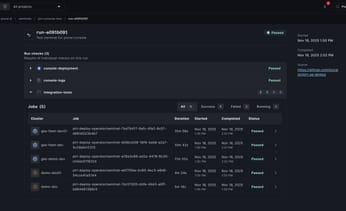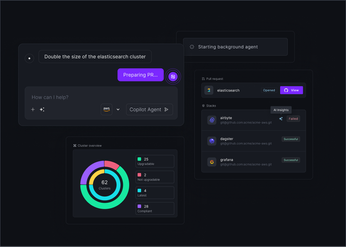
What Is Kubernetes? A Guide to Modern App Management
Learn what are Kubernetes and how they simplify modern app management with automated deployment, scaling, and self-healing for containerized applications.
Before container orchestration, deploying applications meant juggling custom scripts, manual configs, and fragile infrastructure. Scaling was reactive—if a server went down or traffic surged, engineers scrambled to spin up and configure new machines. Kubernetes was built to end that chaos. It’s an open-source platform that automates the deployment, scaling, and lifecycle management of containerized apps, making infrastructure predictable and resilient.
At its core, Kubernetes follows a declarative model: you describe the desired state of your system, and Kubernetes continuously reconciles the actual state to match it. This shift from imperative, hands-on ops to self-healing infrastructure is why it's become the backbone of modern DevOps workflows.
In this guide, we’ll walk through Kubernetes architecture, core features, and how it solves real-world problems for engineering teams managing apps at scale.
Unified Cloud Orchestration for Kubernetes
Manage Kubernetes at scale through a single, enterprise-ready platform.
Key takeaways:
- Kubernetes is the standard for application automation: It provides a robust framework for deploying and scaling containerized applications, using features like self-healing and automated load balancing to build resilient, portable systems across any cloud.
- Operating Kubernetes at scale introduces significant challenges: Despite its power, its inherent complexity creates hurdles in security, resource management, and cost control, which become major bottlenecks when managing a large fleet of clusters.
- A unified platform is essential for managing complexity: Use a tool like Plural to overcome these challenges with a single control plane that provides secure multi-cluster visibility, automates deployments with GitOps, and manages infrastructure as code declaratively.
What Is Kubernetes?
Kubernetes (or K8s) is an open-source platform that automates the deployment, scaling, and management of containerized applications. It acts like an operating system for your infrastructure, abstracting away the underlying machines—whether you're running in the cloud, on-prem, or hybrid. This abstraction gives you a consistent API and control layer to manage workloads at scale.
At its core, Kubernetes operates declaratively: you define the desired state of your system, and it works continuously to reconcile the actual state to match it. For example, if you specify “three replicas of a web app,” Kubernetes ensures that number is always maintained—spinning up or replacing containers as needed. It schedules workloads across your cluster, handles service discovery, load balancing, and organizes containers into logical units, making app management far more predictable and repeatable.
What Problem Does Kubernetes Solve?
Before Kubernetes, deploying and operating apps meant cobbling together scripts, custom tools, and manual processes. Failures required hands-on fixes. Scaling meant manually provisioning and configuring new servers. Kubernetes solves these pain points by automating the full lifecycle of your apps: deployments, rollbacks, self-healing, scaling, and more.
With Kubernetes, your infrastructure becomes resilient by design. It reduces operational burden and frees developers to focus on shipping code instead of firefighting infrastructure issues.
A Brief History of Kubernetes
Kubernetes was born at Google, inspired by their internal system “Borg,” which ran containerized workloads at scale for over a decade. In 2014, Google open-sourced Kubernetes, and shortly after, helped form the Cloud Native Computing Foundation (CNCF) to ensure community-driven, vendor-neutral development.
Since then, Kubernetes has become the industry standard for container orchestration, backed by a thriving open-source community and adopted across enterprises of all sizes.
How Does Kubernetes Work?
Kubernetes follows a declarative model: you describe the desired state of your application—such as “run three replicas of this web server with a specific container image”—and Kubernetes constantly works to keep the actual state in sync. It does this by treating a group of machines as a single pool of compute resources and scheduling your containerized workloads intelligently across them. This model is the backbone of Kubernetes’ automation, making it possible to deploy, scale, and heal applications without manual intervention.
Kubernetes Architecture at a Glance
Kubernetes is a distributed system built for scale and resilience. It abstracts away individual servers—whether virtual or physical—and presents them as a unified cluster. This means you can deploy applications without worrying about which exact machine they’ll land on.
The system follows a client-server architecture with two main components:
- Control Plane – makes all global decisions (like scheduling and maintaining desired state).
- Worker Nodes – execute workloads by running your containers.
This separation allows Kubernetes to automate deployment strategies, handle failovers, and scale workloads dynamically.
The Building Blocks: Clusters, Nodes, and Pods
- Cluster: The entire Kubernetes environment; a collection of nodes working together.
- Nodes: The machines—physical or virtual—that run your applications.
- Pods: The smallest deployable unit, representing one or more containers sharing networking and storage. Containers in a Pod communicate as if they were on the same machine.
The Control Plane and Worker Nodes
The control plane is the brain of the cluster. It manages cluster state, makes scheduling decisions, and ensures your desired state is maintained. The worker nodes run your applications, hosting Pods that perform the actual work. Each node is managed by the control plane through the kubelet, a local agent that keeps the node in sync with cluster instructions.
Managing secure, reliable communication between the control plane and worker nodes—especially across multiple clusters—can be complex. Plural’s agent-based architecture simplifies this by using an egress-only communication model. Worker nodes stay safely within private networks without exposing inbound ports, allowing you to manage clusters across clouds and on-prem environments through a single, secure interface.
Core Kubernetes Features
Kubernetes is built to run distributed systems at scale. It automates complex operational tasks like deployment, scaling, failover, and service discovery—freeing you from the low-level plumbing of container management. Its modular design and declarative APIs allow engineering teams to codify infrastructure and build resilient, self-healing systems.
Container Orchestration Made Simple
Kubernetes is fundamentally a container orchestrator. You describe your application’s desired state—how many instances to run, what image to use, what resources it needs—and Kubernetes ensures the cluster converges to that state. It schedules containers across a pool of machines, restarts failed processes, and manages dependencies. This lets developers focus on shipping code instead of scripting deployments. Plural's GitOps-native Continuous Deployment engine builds on this by syncing your manifests to any number of clusters for consistent, hands-off rollouts.
Automatic Scaling and Load Balancing
With Kubernetes, you don’t have to manually provision resources to handle traffic surges. It can automatically scale Pods based on metrics like CPU or custom signals via the Horizontal Pod Autoscaler. Built-in load balancing evenly distributes network traffic to avoid bottlenecks. This elasticity ensures apps stay performant under load and efficient during idle times. Tools like Plural’s multi-cluster dashboard offer unified resource insights, helping you tune scaling policies across environments.
Self-Healing by Design
One of Kubernetes’ superpowers is self-healing. It constantly monitors the health of your containers and nodes, restarting or rescheduling them when failures occur. For example, if a Pod crashes, Kubernetes replaces it automatically. If a node goes offline, workloads are rescheduled elsewhere. This kind of resilience significantly reduces downtime and operational overhead. Plural enhances observability around these events, giving you real-time insights and root-cause context so you’re never in the dark.
Built-In Service Discovery and Networking
In Kubernetes, services don’t need to worry about ephemeral IPs. It provides a built-in DNS system that assigns a stable name and virtual IP to each service. This simplifies communication between microservices and enables internal load balancing. Behind the scenes, Kubernetes manages networking across all Pods in the cluster. Plural reinforces this with a secure, egress-only communication model—ideal for managing clusters in locked-down environments without exposing inbound endpoints.
Declarative Configuration via APIs
Everything in Kubernetes is managed via declarative config files and the Kubernetes API server. You define the desired state of your system in YAML—what services to run, how they should behave—and Kubernetes continuously works to make that state a reality. This enables reproducibility, version control, and infrastructure-as-code workflows. Plural Stacks extend this philosophy by letting you declaratively manage infra tools like Terraform or Ansible—bridging Kubernetes and non-Kubernetes resources under one Git-based model.
Why Use Kubernetes?
Kubernetes has become the go-to standard for container orchestration because it solves key operational challenges in modern app delivery. It automates the deployment, scaling, and recovery of containerized workloads, helping engineering teams replace brittle manual processes with a resilient, declarative system. For platform and DevOps teams, Kubernetes brings consistency, control, and velocity—across environments and at scale.
Scale and Heal Automatically
Kubernetes excels at automatic scaling and self-healing. Using Horizontal Pod Autoscalers, you can scale workloads up or down based on metrics like CPU, memory, or custom signals. If a container crashes or fails a readiness check, Kubernetes will restart or reschedule it automatically—ensuring high availability with minimal human intervention. This built-in resilience lets your team focus on shipping features, not babysitting infrastructure.
Run Anywhere, Avoid Lock-In
As an open-source platform, Kubernetes abstracts away the underlying infrastructure. Whether you're running on AWS, GCP, Azure, or on-prem, Kubernetes provides a consistent deployment model. You write your manifests once and deploy them anywhere—supporting hybrid and multi-cloud strategies without vendor lock-in. Plural extends this by offering an agent-based architecture to manage clusters across public clouds, private VPCs, or edge environments—all from a single control plane.
Maximize Resource Efficiency
Kubernetes improves resource utilization through intelligent bin packing. It places pods onto nodes based on declared resource requests and limits, making efficient use of compute and memory across your cluster. This shared model eliminates the waste of over-provisioned VMs, leading to better cost-efficiency. Fine-grained resource policies and quotas help prevent noisy neighbors and ensure fair access for all workloads.
Streamline Deployments and Rollbacks
Kubernetes enables reliable, repeatable deployments using its declarative configuration model. Rather than scripting step-by-step actions, you define the desired state in YAML, and Kubernetes handles reconciliation. Built-in support for rolling updates and rollbacks ensures smooth upgrades with minimal downtime. Tools like Plural build on this by offering GitOps-based pipelines with approval gates and multi-cluster coordination—so you can scale your deployments with confidence and control.
How Does Kubernetes Compare to Other Tools?
Kubernetes wasn’t the only contender when container orchestration began to take off. Early alternatives like Docker Swarm and Apache Mesos offered simpler or more general-purpose approaches, but Kubernetes has emerged as the industry standard. Understanding why helps clarify when and why to use it.
Lightweight Tools vs. Full Orchestrators
Tools like Docker Compose are useful for local development or running multi-container apps on a single host. But they fall short in production environments, where you need dynamic scaling, high availability, and fault tolerance across clusters. Kubernetes addresses these needs with a declarative model and rich abstractions for networking, storage, scheduling, and state management.
Kubernetes vs. Docker Swarm
Docker Swarm emphasizes simplicity and tight Docker integration, making it approachable for smaller teams. However, it lacks advanced features like custom resource definitions, robust networking plugins, and mature support for enterprise-grade use cases. Kubernetes, while more complex to operate, is built for running distributed systems at scale and offers far greater flexibility and automation.
Kubernetes vs. Apache Mesos
Apache Mesos is a general-purpose cluster manager that can run everything from containers to Hadoop and Spark jobs. But its flexibility comes at the cost of complexity—managing containers typically requires additional tools like Marathon. Kubernetes, by contrast, focuses solely on containerized workloads, offering a more opinionated and developer-friendly experience that led to faster adoption and stronger community support.
What Makes Kubernetes Different?
Kubernetes’ strength lies in its declarative model and modular design. You don’t script out how to run an application—you describe the desired state, and the control plane ensures the system gets there and stays there. This model powers capabilities like:
- Self-healing containers
- Rolling updates and rollbacks
- Built-in service discovery and load balancing
But Kubernetes doesn’t try to be a full PaaS. It provides the orchestration engine, leaving CI/CD pipelines, observability stacks, and databases to other tools. This separation of concerns allows for flexibility, but managing all the moving parts can become overwhelming at scale.
That’s where platforms like Plural come in—offering a unified control plane that not only manages your Kubernetes clusters, but also standardizes and automates the lifecycle of critical add-ons. This helps teams tame complexity and build repeatable infrastructure across any environment.
When Should You Use Kubernetes?
Kubernetes is a powerful tool—but it’s not always the right one. Its strengths shine in environments where managing application complexity, scale, and uptime is mission-critical. If your team is grappling with operational overhead from growing applications or trying to adopt cloud-native development, Kubernetes offers a standardized, automated platform that can meet those demands. However, it introduces its own learning curve and operational footprint, so it’s important to assess whether your needs truly justify the switch.
Let’s explore some of the key scenarios where Kubernetes excels.
Powering Microservices Architectures
Kubernetes is purpose-built for managing microservices. In a microservices architecture, applications are broken down into independent components that communicate via APIs. This design brings modularity, but also operational complexity—especially when services need to be deployed, scaled, and monitored independently.
Kubernetes addresses this challenge by providing primitives that support distributed service management. With Kubernetes, you can:
- Deploy each service independently
- Scale individual services without affecting others
- Ensure high availability through built-in health checks and self-healing
- Automate service discovery and load balancing
This level of control is difficult to replicate manually or with simpler orchestration tools. By adopting Kubernetes, teams can streamline operations while maintaining the flexibility and fault isolation that microservices promise.
Building Robust CI/CD Pipelines
For teams implementing modern CI/CD practices, Kubernetes is a natural fit. It integrates seamlessly into pipelines designed around containerized applications, enabling automated deployments, rollbacks, and environment parity.
Kubernetes supports a declarative model—you define your application’s desired state, and Kubernetes continuously ensures that this state is met. This infrastructure-as-code approach aligns perfectly with GitOps-style workflows.
Plural enhances this with its Continuous Deployment engine, offering:
- Automated pull request generation for changes
- Approval workflows for multi-stage promotion
- Git-backed deployment histories
The result is a safer, more auditable CI/CD pipeline that supports high-frequency, low-risk releases.
Developing Cloud-Native Applications
Kubernetes is foundational for cloud-native development. These applications are designed to run in highly dynamic, ephemeral environments where infrastructure may change rapidly. Kubernetes abstracts away these concerns, letting developers focus on writing code while the platform handles scheduling, scaling, and recovery.
Key Kubernetes features that support cloud-native patterns include:
- Auto-scaling based on resource usage
- Rolling updates and rollbacks
- Self-healing through pod restarts
- Flexible networking and service meshes
With Plural, teams can take this a step further by exposing a Self-Service Catalog. Developers can easily deploy standardized tools, services, and applications while platform teams maintain governance, compliance, and best practices behind the scenes.
Running Stateful Applications and Databases
Kubernetes has evolved well beyond stateless services. Today, it’s a viable platform for running stateful workloads such as databases, queues, and storage-backed applications.
Features that enable this include:
- StatefulSets: for maintaining stable network identities and persistent storage
- PersistentVolumes and StorageClasses: for dynamic provisioning of durable storage
- Secrets Management: for handling credentials and sensitive data securely
- Rolling Updates: for non-disruptive maintenance and versioning
Managing stateful workloads on Kubernetes still requires careful planning. Plural simplifies this by managing the supporting infrastructure using Terraform or other IaC tools, tying everything together with Kubernetes manifests for a unified, repeatable deployment pattern.
How to Get Started with Kubernetes
Kubernetes is a powerful system, but it can seem overwhelming at first. The best way to learn it is by doing—starting small, experimenting locally, and gradually layering in complexity. This guide walks you through that journey, from understanding Kubernetes basics to deploying your first containerized app.
Learn the Core Concepts First
Before diving into code or configuration files, it's essential to understand how Kubernetes works under the hood. At a high level, Kubernetes automates the deployment, scaling, and operation of containerized applications. Here are the key components:
- Container: A lightweight, portable unit that packages your application with everything it needs to run.
- Pod: The smallest unit in Kubernetes. A pod can contain one or more containers and shares networking and storage.
- Node: A physical or virtual machine that runs pods.
- Cluster: A group of nodes managed by a control plane, acting as one logical system.
- kubectl: The CLI tool used to interact with Kubernetes.
These building blocks form the foundation of how Kubernetes works—and understanding them gives you the mental model you’ll need as you start experimenting.
Set Up a Local Cluster
You don’t need cloud infrastructure to start using Kubernetes. Several tools make it easy to spin up a cluster locally:
- Minikube: Runs a single-node Kubernetes cluster in a virtual machine on your laptop. Great for beginners.
- Kind (Kubernetes IN Docker): Creates Kubernetes clusters inside Docker containers. Lightweight and fast.
- Docker Desktop: Comes with a built-in Kubernetes option. Ideal if you already use Docker for local development.
All of these provide the full Kubernetes API and let you use kubectl, giving you an environment that behaves like a real-world cluster. It's your personal sandbox for experimentation.
Deploy a Simple Application
Start with something minimal—a single container running a simple web app. Here’s how that process looks:
- Write a manifest: A YAML file that defines a
Deploymentand aService. For example, you can run a container with an NGINX server and expose it on port 80. - Apply the manifest: Use
kubectl apply -f your-file.yamlto send it to the cluster. - Inspect and scale: Use
kubectl get pods,kubectl describe, andkubectl scaleto see what’s happening behind the scenes and experiment with scaling replicas.
This step gives you a practical sense of how Kubernetes maintains application state and handles updates, crashes, and rescheduling—key features you’ll rely on in production.
Build Confidence with Iteration
Don’t try to rebuild your entire architecture on day one. Take an iterative approach:
- Simulate failures and see how Kubernetes reacts.
- Scale your deployment up or down and watch the pods adjust automatically.
- Explore how services provide stable networking across changing pods.
These small experiments help you internalize Kubernetes’ declarative nature: you describe the state you want, and the system continuously works to match it.
Go Beyond the Basics
Once you're comfortable with deploying a simple app, explore more advanced topics:
- Persistent storage (using PersistentVolumes and StorageClasses)
- Secrets and ConfigMaps (to manage configuration)
- Network Policies (for controlling traffic)
- Helm (for packaging and managing applications)
These features are essential when you're ready to move from single-node clusters to real-world infrastructure.
Scaling to Production with GitOps
When managing multiple applications and clusters, kubectl apply won’t scale. That’s where GitOps comes in—a model where all deployments are driven from version-controlled configuration.
Plural’s Continuous Deployment engine extends this model. It integrates with Git, automates rollouts, handles approvals, and maintains consistency across environments. It’s the natural next step once you’ve mastered the basics and are ready to build resilient infrastructure at scale.
What Are the Challenges of Kubernetes?
Kubernetes is a powerful orchestration platform, but running it effectively—especially at scale—introduces a host of operational challenges. From mastering its complex architecture to keeping infrastructure costs under control, teams must navigate a steep learning curve and make critical architectural decisions. The good news: with the right tooling and strategies, many of these pain points can be mitigated, allowing teams to focus more on delivering applications and less on managing complexity.
1. The Steep Learning Curve
Kubernetes has a reputation for being hard to learn—and with good reason. Its architecture, extensive API surface, and broad ecosystem of tooling demand a high level of technical understanding. Even experienced engineers can struggle with the intricacies of networking, storage, YAML manifests, and resource configuration. These hurdles slow down development and create friction in onboarding new team members.
Plural helps flatten this curve through its Self-Service Catalog, which enables platform teams to expose standardized, pre-configured application stacks. Developers can deploy what they need—securely and reliably—without having to become Kubernetes experts.
2. Resource Management and Cost Control
Kubernetes offers granular control over resource allocation, but getting it right is another story. Misconfigured resource requests, lack of autoscaling, and poor visibility can quickly lead to inefficient usage and ballooning cloud costs. In fact, 93% of enterprise platform teams report major challenges in managing Kubernetes-related cloud spend.
Plural’s Multi-Cluster Dashboard solves this by offering unified visibility into resource usage across all your clusters. Teams can spot underutilized workloads, reallocate resources, and enforce usage policies—all from a single pane of glass—helping keep performance high and costs in check.
3. Security and Compliance
Running Kubernetes securely isn’t just about locking down a few endpoints. It requires continuous attention to network policies, RBAC, container image integrity, and compliance standards. Without clear governance, large-scale deployments can quickly become unmanageable and vulnerable.
Plural is designed with security-first architecture, featuring an egress-only model that reduces your attack surface. It integrates seamlessly with SSO providers and leverages Kubernetes-native impersonation to enforce fine-grained RBAC consistently across your fleet—making it easier to stay secure and compliant from day one.
Related Articles
- What is Kubernetes Used For? Explained Simply
- Deep Dive into Kubernetes Components
- Kubernetes Mastery: DevOps Essential Guide
- Top 5 Kubernetes Alternatives: Simplify Your Orchestration
- How Does Kubernetes Work? A Comprehensive Guide for 2025
Unified Cloud Orchestration for Kubernetes
Manage Kubernetes at scale through a single, enterprise-ready platform.
Frequently Asked Questions
I hear Kubernetes is complex. How can I manage it without a huge team? You're right, Kubernetes has a reputation for complexity, and managing it raw can be a heavy lift. The key is to use a platform that abstracts away the repetitive, difficult parts. Instead of having every engineer become a Kubernetes expert, you can use a tool that provides standardized workflows. Plural, for example, offers a Continuous Deployment engine and a Self-Service Catalog. This allows a small platform team to define best practices for deployments and infrastructure, which developers can then use without needing to write complex YAML files from scratch.
What's the real difference between a Pod and a Container? Think of it this way: a container is a single, self-contained package of your application's code and dependencies. A Pod is the smallest unit that Kubernetes manages, and it can hold one or more containers. While you often run just one container per Pod, grouping them is useful when you have tightly coupled processes that need to share resources like networking and storage. The Pod provides the shared environment, and the containers run inside it.
Do I have to manage all the security and access control myself? While Kubernetes provides the building blocks for security, like Role-Based Access Control (RBAC), you are responsible for configuring and enforcing it. This can become a significant task across many clusters. A management platform simplifies this by centralizing control. Plural integrates with your company's Single Sign-On (SSO) provider and uses an egress-only architecture, which means you don't have to expose your clusters to inbound traffic. This allows you to manage access and apply consistent security policies across your entire fleet from a single, secure control plane.
Can I really run my databases on Kubernetes? Yes, absolutely. While Kubernetes was initially known for stateless applications, it has matured significantly to support stateful workloads like databases. It provides core components like StatefulSets and PersistentVolumes that ensure your data has stable network identity and persistent storage, even if the underlying Pods are restarted or moved. For managing the underlying cloud infrastructure that these databases require, Plural's Stacks feature allows you to automate the provisioning of resources like managed databases or storage volumes using Terraform, all within the same declarative workflow.
Does using Kubernetes lock me into a specific cloud provider? Quite the opposite. One of the biggest advantages of Kubernetes is that it provides a consistent API layer that works across any cloud provider or on-premise environment. This prevents vendor lock-in by allowing you to define your application once and deploy it anywhere. Plural enhances this portability with its agent-based architecture, which can securely manage clusters in any environment—public cloud, private data centers, or even on the edge—all from a single interface.
Newsletter
Join the newsletter to receive the latest updates in your inbox.









